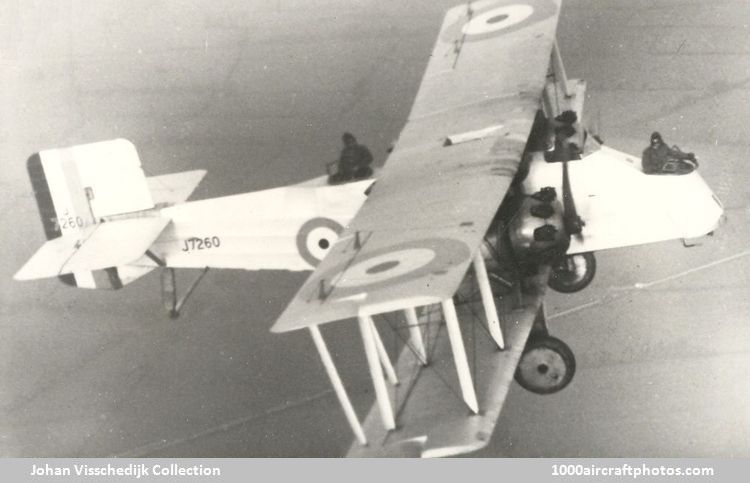08/31/2010. Remarks by Johan Visschedijk: "Build to Specification 30/22 for a medium-range day bomber landplane with two engines, the Bugle appeared in 1923, and the first two P.25 Bugle Mk.Is, s/n J6984 and J6985, were three-seaters evolved around a pair of 400 hp Bristol Jupiter II/III air-cooled radial engines mounted at mid-gap between the three-bay, equal-span 65 ft 0.5 in (19.82 m) wings. Fuel was contained in two large semi-circular tanks fitted flush with the undersides of the upper center section.
In place of the wire connections used between the ailerons of its predecessors, the Bolton and the Bourges, struts were fitted to those of the Bugle. Construction of the Bugle was mainly steel, and the engine mountings of circular-section tube were hinged. The Bugle Mk.Is bomb load was stored externally, and the machine's pair of Scarff-mounted Lewis guns were disposed one in the nose, with the other in a dorsal position aft of the wings. Oleo-pneumatic shock absorbers were applied to the divided main wheels and to the tail skid also.
During 1924 a modified Bugle Mk.I, s/n J7235, was completed as a four-seater. The span had been reduced to 62 ft 6 in (19.05 m), the engines changed to a pair of 400 hp Jupiter IVs and the fuel tankage increased. J7235 joined No. 58 Squadron in 1925 for a period of Service Trials and assessment alongside the current Virginia, and spectators at the 1925 Hendon Air Display were treated to a remarkable exhibition of the Bugle's aerobatic prowess, even to the inclusion of a loop. J7259 and J7260 were two additional Bugle Mk.Is ordered on January 21, 1924.
1925 produced another four-seat version of the square-cut Bugle, the P.25A Bugle Mk.II, with a change of engines to a pair of 450 hp Lions liquid-cooled engines mounted on the lower wings. The previously exposed ventral bomb-racks were given a streamlined fairing, and the tanks were transferred from their original exposed position under the upper center section to a new location inside the fuselage. Maximum weight rose to 8,914 lb (4,043 kg). Only two Mk.IIs were built, s/n J7266 and J7267.
The Bugle was an excellent design displaying good performance and superb powers of maneuver, but its advent at a time of crippling financial stringency reduced its chances of adoption as RAF equipment. Even so, the experience gained by Boulton & Paul with the Bourges, Bolton and the seven Bugles was to stand the company in good stead in the near future."
